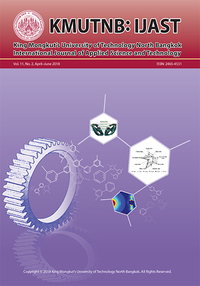Bioethanol Production from Ceratophyllum demersum L. and Carbon Footprint Evaluation
Main Article Content
Abstract
The aim of this research was to find the suitable conditions for bio-ethanol production from Ceratophyllum demersum L., an abundant aquatic plant. The parameters affected to alcohol production were evaluated. Percentage of solid (10, 20, and 30% (w/v)), the amount of yeast (5, 10, and 15% (w/v)), pH value (4, 5, and 6) and temperature (30, 35, and 40°C) were carried out. The results elucidated that the conditions to produce the maximum bio-ethanol from Ceratophyllum demersum L. was applied with 10% (w/v) of solid, 10% (w/v) of yeast, controlled pH value of 6 and temperature of 30°C. The highest yield of bio-ethanol production was reached 2.92 g ethanol/L within 24 h. Moreover, the Carbon Footprint for ethanol production was calculated only from 2 steps of life cycle analysis which were the step of raw material acquisition from macro algae cultivation and manufacturing process from bio-ethanol production. Consequently, the carbon footprint for ethanol production from Ceratophyllum demersum L. was 77.88 kg CO2 equivalent.
Article Details
References
[2] N. Hicks, U. Vik, P. Taylor, E. Ladoukakis, J. Park, F. Kolisis, and K. S. Jakobsen, “Using prokaryotes for carbon capture storage,” Trends in Biotechnology, vol. 35, pp. 22–32, 2017.
[3] K. Ullah, M. Ahmad, V. K. Sharma, P. Lu, A. Harvey, M. Zafar, and S. Sultana, “Assessing the potential of algal biomass opportunities for bioenergy industry: A review,” Fuel, vol. 143, pp. 414–423, 2015.
[4] M. Y. Noraini, H. C. Ong, M. J. Badrul, and W. T. Chong, “A review on potential enzymatic reaction for biofuel production from algae,” Renewable & Sustainable Energy Reviews, vol. 39, pp. 24–34, 2014.
[5] A. Singh, P. S. Nigam, and J. D. Murphy, “Renewable fuels from algae: An answer to debatable land based fuels,” Bioresource Technology, vol. 102, pp. 10–16, 2011.
[6] J. Trivedi, M. Aila, D. P. Bangwal, S. Kaul, and M. O. Garg, “Algae based biorefinery – how to make sense?,” Renewable & Sustainable Energy Reviews, vol. 47, pp. 295–307, 2015.
[7] A. Demirbas, “Use of algae as biofuel sources,” Energy Conversion and Management, vol. 51, pp. 2738–2749, 2010.
[8] S. Vassilev, D. Baxter, L. Andersen, C. Vassileva, and T. Morgan, “An overview of the organic and inorganic phase composition of biomass,” Fuel, vol. 94, pp. 1–33, 2012.
[9] S. Vassilev, C. Vassileva, and V. Vassilev, “Advantages and disadvantages of composition and properties of biomass in comparison with coal: An overview,” Fuel, vol. 158, pp. 330–350, 2015.
[10] B. M. In and M. A. Curran, Life-Cycle Assessment: Inventory Guidelines and Principles. US: CRC press, Inc., 1994.
[11] N. Casolani, C. Pattara, and L. Liboratore, “Water and carbon footprint perspective in Italian durum wheat production,” Biomass and Bioenergy, vol. 58, pp. 394–402, 2016.
[12] J. Yang and B. Chen, “Energy-based sustainability evaluation of wind power generation systems,” Applied Energy, vol. 177, pp. 239–246, 2016.
[13] B. Chen, “Energy, ecology and environment: A nexus perspective,” Energy, Ecology and Environment, vol. 1, no. 1, pp. 1–2, 2016.
[14] B. P. Weidema, M. Thrane, P. Christensen, J. Schmidt, and S. Løkke, “Carbon footprint. A catalyst for life cycle assessment?,” Journal of Industrial Ecology, vol. 12, pp. 3–6, 2008.
[15] S. Ewanick and R. Bura, “The effect of biomass moisture content on bioethanol yields from steam pretreated switchgrass and sugarcane bagasse,” Bioresource Technology, vol. 102, pp. 2651–2658, 2011.
[16] M. H. Yoon, Y. W. Lee, C. H. Lee, and Y. B. Seo, “Simultaneous production of bio-ethanol and bleached pulp from red algae,” Bioresource Technology, vol. 126, pp. 198–201, 2012.


